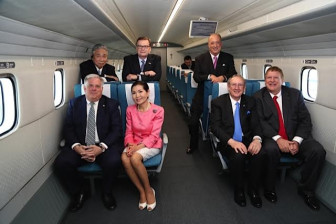By Michael Collins
For MarylandReporter.com
The Hogan administration secured a $27.8 million federal grant last month to study the feasibility of a magnetic levitation (MagLev) train between Washington, D.C. and Baltimore. The grant can be used for planning and engineering costs.
MagLev trains are propelled through a guideway by powerful magnets. The magnetic force also lifts the train above the surface to reduce friction, allowing smoother, quieter rides and a top-end speed of more than 300 MPH.

Gov. Larry Hogan and his wife Yumi, far left, seated take a quick ride on the MagLev train in Japan, June 2014. Governor’s Office photo
Gov. Larry Hogan rode a MagLev train in Japan in 2015 and became convinced this technology can help revolutionize travel in the Baltimore-Washington corridor and can serve as the first phase of a high-speed rail to New York and Boston.
This isn’t the first attempt to bring MagLev to the Baltimore-Washington Corridor. MagLev originally received funding from the Clinton administration that was gladly accepted by then-Gov. Paris Glendenning. Maryland Democrats seemed to favor the project.
Partisan opposition
Local opposition was initially small, but seemed to take grow when President George W. Bush was in the White House and Gov. Robert Ehrlich was in Government House. Perhaps local politicians from Anne Arundel and Howard Counties really were representing opposition of their constituents, but back then their opposition seemed more partisan than genuine.
Things changed when President Barack Obama was in the White House and Gov. Martin O’Malley was in Government House. In 2009, the Obama Administration passed the Recovery Act largely along party lines. President Obama’s team was enamored with high-speed rail, and in 2010, launched the Transportation Initiative Generating Economic Recovery (TIGER) grant program. TIGER grants were designed to jump-start spending on a national high-speed rail system.
Amid the rise of the TEA Party, TIGER projects—especially high-speed rail—became symbolic of government waste. When Republican governors from Wisconsin, Ohio, and Florida rejected TIGER funds requested by their Democratic predecessors, the dream of a national high-speed rail system effectively died.
While their opposition was criticized as mindless partisanship their rejection of TIGER funds was rooted in practicality. The cost of any future intra-state high-speed rail system would be borne by their respective states, and their constituents had neither the wallet nor the desire to fund such a boondoggle, and there was no real demand for such projects in their states.
High cost
The enormous cost of high-speed rail is a real concern, with California’s high-speed rail serving as Exhibit A. The project is intended to link Los Angeles to San Francisco, but resistance in the urban corridor, along with the cost of land, makes a direct route politically unfeasible. So the planned route will go East of Los Angeles to Bakersfield, then up through the agricultural heartland. The projected cost for this 500-mile route has ballooned to $68 billion, but that is sure to climb.
Ironically, California’s proposed bullet train route through sparsely populated areas in the Central Valley, like Merced, Fresno, and Bakersfield may induce growth by making them short commutes to Silicon Valley and L.A. respectively, defeating the state’s Smart Growth agenda.
Northeast corridor
The Northeast corridor faces a different challenge because it is already developed—there is nothing similar to California’s Central Valley to run a train through. With roads, railroads, and air traffic running near capacity from Washington to Boston, transportation planners are looking for a breakthrough to accommodate growing populations and congestion.
Population density and traffic congestion help make the Washington-Boston corridor AMTRAK’s only moneymaking route in the nation. Even so, AMTRAK is slow and expensive. It is cheaper and faster for most people to drive or fly from Washington to Boston than it is to take AMTRAK. The Acela takes six and a half hours, only 90 minutes less than it takes to drive.
The Hogan administration says it can complete the 40-mile MagLev for $10-$12 billion, and use public-private partnerships to defray the cost. The Japanese government has pledged $5 billion in financing for the project and the railway has said it will not charge licensing fees for the technology, which can make the trip in 15 minutes.
By contrast, the hokey-pokey Purple Line light rail will go 16 miles in 45 minutes and cost $5.6 billion.
MagLev is a breakthrough technology that can revolutionize regional transportation even as it adds thousands of high-paying construction jobs. Maryland is well positioned to start first leg of the high-speed rail revolution in the Northeast corridor. It’s time for the MagLev to move forward.
Michael Collins can be reached at michael.collins.capital@gmail.com.







Another over-priced “toy” that very few will be able to afford to use…
Fix the railbed so that the Acela train can run at top speed first… And other trains can do the same !
I’m tired of having my taxes being used for something that I’ll never use…
This author has no clue. If he thinks steel wheel on rail is expensive, how much do you think maglev will be.
[Kraut has no clue.] Not anywhere near the cost of what it will take to expand the interstate in this region, or fight multi-trillion dollar wars to maintain an energy infrastructure which turns out to be the largest of all “boondoggles.” In point, for the same price we’ll pay over 30 years for the Iraq War in interest on war bonds, veteran’s benefits, and the direct cost of the war itself (4-8 trillion in total), we could have connected every major city in the United States by maglev at a cost of $80 million/mile on average, and let everyone in the country ride it whenever they wish for 20 years free of charge, then destroy it just for fun and we still wouldn’t have touched the cost of the Iraq War.
Why Conservatives think they know about economics, or can unabashedly express an opinion about government projects, given their fear-mongering misdeeds in the Middle East which have taken and will take far more money and resources than any combination of mass transit projects even the most ambitious planner could imagine, is beyond me. The link between how we use energy in our daily lives and our propensity to engage in conflict (under false pretenses) is undeniable. I for one am tired of hearing conservatives tell me what is a waste of money when they have exemplified not even an ounce of skepticism that their ambitions, views, and abstracts on every subject could (and most likely are) dead wrong.
It’s obvious you lack basic comprehension skills
Kraut is completely wrong. The Japanese maglev tech is expensive because they have chosen to plan most of their line in a tunnel. That is not required for maglev trains. It is the tunnel that makes it very expensive. But it also solves many other problems in areas of high population density. However the German developed Transrapid maglev tech is much cheaper than the Japanese tech, while still having the same high speeds +311mph. That the North East Corridor is using Japanese maglev tech is only a result of good lobbying and pr from the Japanese, not an economic decision.
Want to know why the Germans didn’t build anything more than the Transrapid test track and stuck with traditional high speed rail? It was too expensive
As with the US current choice of the Japanese maglev tech instead of the cheaper German one, it is all about lobbying and pr and politics. Not primarily about economy. Unfortunately politics is not always rational.